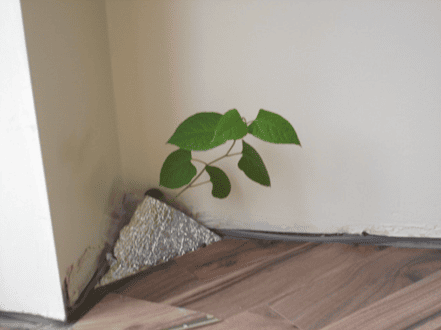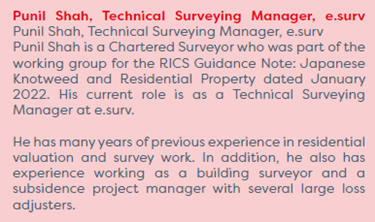Japanese Knotweed and Residential Property.

Japanese Knotweed is a hardy perennial bamboo-like plant. It is now present throughout most of the UK. A piece of root the size of a little fingernail can grow into a new plant. It has caused serious problems to areas including roadsides, riverbanks and derelict land by displacing native plants and even causing structural damage. It is an offence under the Wildlife and Countryside Act 1981 to ‘plant or otherwise cause Japanese Knotweed to grow in the Wild’, and the Environmental Protection Act 1990 designates Japanese Knotweed-contaminated soil as ‘controlled’ waste.
The 2012 RICS Information Paper “Japanese Knotweed and Residential Property” has been superseded by the publication of the January 2022 RICS Guidance Note “Japanese knotweed and residential property”.
The guidance note has been live since March 2022 and the purpose of this article is to assess the main changes from a lender perspective. We have also provided an update on lender adoption to date along with our concerns on implementation.
Does Japanese Knotweed damage buildings?
The guidance indicates different views on the extent of the growth and damage caused, with recent studies showing:
- The plant can grow up to 2 metres in height, and the spread is more likely to be 3 metres instead of 7 metres.
- The root system extends to a distance of 3 metres underground.
- Japanese knotweed rarely causes structural damage to substantial buildings such as dwellings.
- Even within immediate proximity to significant structures, Japanese knotweed is not typically associated with major issues such as subsidence, heave or impact damage.
- Large stands or growths of Japanese knotweed, if left uncontrolled, have been known to damage external residential features. These include lightweight structures, freestanding walls, retaining walls, paths, hardstandings, drains and other ancillary features.
Most buildings insurance policies don’t cover damage caused by knotweed, and it is generally not covered by new build warranty cover. Previously, several lenders claimed they could not obtain buildings insurance cover for properties affected by Japanese knotweed. The latest RICS guidance may change the views of insurers, as structural damage to substantial buildings is rare.
Does the previous 7-metre rule apply for mortgage purposes?
The latest RICS guidance no longer adopts the previous category 1-4 approach based on the 7-metre distance from boundaries, habitable space, conservatories and garages. Instead, a new assessment framework now applies based on management categories. This now includes the impact on amenity as well as any damage to structures. This aspect is the key difference from the 2012 guidance and also ensures that the valuation surveyor uses professional judgement rather than a binary decision.
Amenity space and assessing if it is impacted
Amenity space is regarded primarily as open areas intended for recreation, leisure or convenience within the boundaries of a property. Typically, lawns, patios, paths, driveways, hardstandings, etc. are included in this definition. The valuer will need to decide if the Japanese knotweed is impacting the amenity space. This is where it is likely to prevent the use of, or restrict access, to amenity space with the following factors taken into consideration:
- Size of the plot – growth within a small plot is more likely to impact amenity space even if it is some distance from the main dwelling.
- Considering the number and sizes of individual stands of Japanese knotweed and their relation to the size of the plot.
- The location of the growth including potential areas where the property could be extended, on side pathways, driveways and patio areas.
- The remediation process required.
What are the management categories that now apply for mortgage valuations?
Where valuers identify Japanese Knotweed, the infestation must be divided into four categories A-D:
• Category A – the growth is causing visible damage to the subject property.
• Category B – the growth is impacting the amenity space of the subject property.
• Category C – the growth is within the boundaries but not impacting the amenity space of the subject property.
• Category D – the growth is on a neighbouring property or land.
If “category A” then a valuation should not be provided pending a further investigation report. A further investigation report will be required from a specialist firm to investigate the full extent of the infestation and to confirm costs for the necessary treatment work. The report must be from a remediation specialist who is a member of a recognised trade body and the completion of any recommended works will need to be under a Japanese Knotweed Management Plan, with the benefit of an insurance-backed guarantee.
If “category B” then a valuation should not be provided pending a further investigation report. A further investigation report will be required from a specialist firm to investigate the full extent of the infestation and to confirm costs for the necessary treatment work. The report must be from a remediation specialist who is a member of a recognised trade body and the completion of any recommended works will need to be under a Japanese Knotweed Management Plan, with the benefit of an insurance-backed guarantee.
If “category C” then a present condition valuation can be provided with no further action required subject to checking individual lender guidance. Nonetheless, the valuation must reflect any blight that still may apply.
If “category D” then a present condition valuation can be provided with no further action required subject to checking individual lender guidance. Nonetheless, the valuation must reflect any blight that still may apply.
Will the new guidance note reduce the stigma associated with Japanese knotweed?
The new guidance attempts to consider the current perception of the plant in terms of the impact on saleability and values being disproportionate in relation to the cost of management/treatment. The paper, however, does go on to acknowledge that the stigma of Japanese knotweed must be reflected in the valuation. Any reduction in the stigma will depend upon the forthcoming market evidence following the longer-term implementation of the new guidance.
When providing a market valuation, valuers are likely to be faced with a dearth of comparable evidence however applying a diminution based purely on the cost of management/treatment is unlikely to fully reflect the level of blight and disruption. The supporting rationale for the valuation should include:
- The wider market context – factors such as supply and demand, current open market conditions and the type of property will need to be considered.
- An infestation on adjoining land which would be outside the control of a prospective purchaser – this may deter many potential purchasers or lead to higher diminution due to the need for expensive remedial measures such as root barriers.
- The disruption likely during and before remediation – an example may be where the property cannot be extended without eradication involving significant excavation.
- Restrictions on use of the property and impact during remediation – smaller plots may have significantly reduced amenity space that will have to be reflected in value and not just the cost of treatment works.
- Post-remediation impact on future saleability – previous treatments will have to be declared to new purchasers who may negotiate a lower sale price as a result.
Areas of concern and lender adoption so far
Most lenders have adopted the guidance in terms of the management categories, however, subsequent actions do vary. Most are adhering to the new guidance in terms of actions needed, however, some are introducing their own policy such as:
• Declining category A and B cases altogether.
• Requiring declines for category C and D cases pending further review.
Our discussions with lenders have resulted in further debate around the subject of when amenity space would be impacted. It has generally been agreed that this is the most subjective area of the new guidance and open to interpretation. Long-term problems could be inconsistencies in terms of how individual surveyors apply the guidance.
The guidance intends to lower the stigma and public perception and allow more dwellings to transact with a more proportionate view based on scientific evidence and professional judgement.
